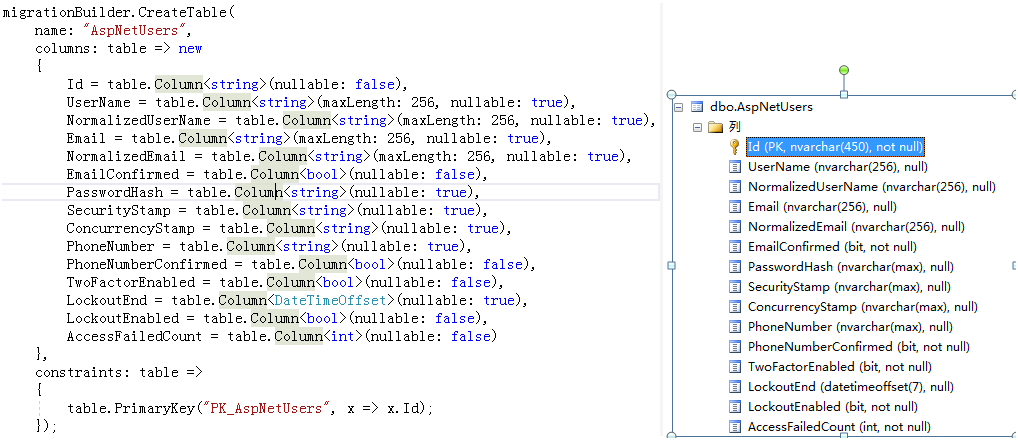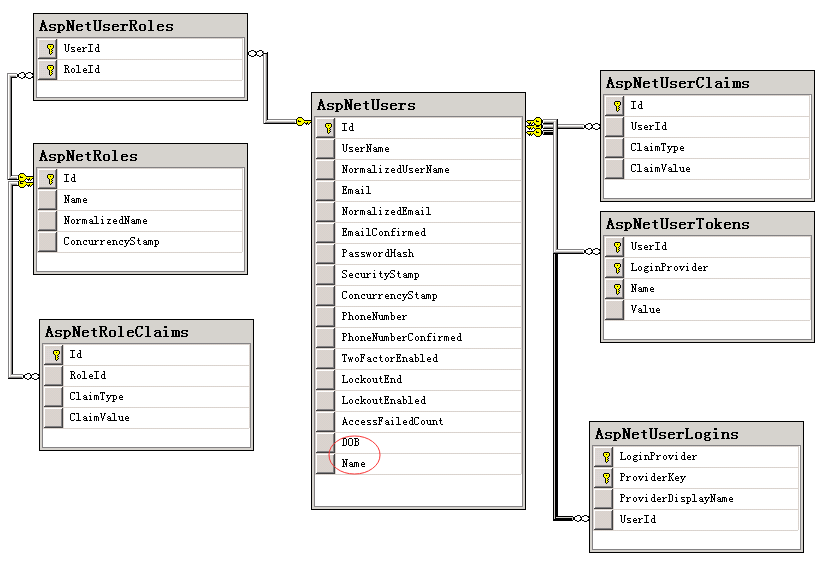一.概述 ASP.NET Core Identity提供了一個框架,用於管理和存儲在 ASP.NET Core 應用中的用戶帳戶。 Identity添加到項目時單個用戶帳戶選擇作為身份驗證機制。 預設情況下,Identity可以使用的 Entity Framework (EF) Core 數據模型。 ...
一.概述
ASP.NET Core Identity提供了一個框架,用於管理和存儲在 ASP.NET Core 應用中的用戶帳戶。 Identity添加到項目時單個用戶帳戶選擇作為身份驗證機制。 預設情況下,Identity可以使用的 Entity Framework (EF) Core 數據模型。 本文介紹如何自定義的身份標識模型。
1.1 下麵是已經存在的身份模型, 由以下實體類型組成:
|
實體類型 |
說明 |
關係 |
| Users | 登錄用戶 | |
|
Roles |
角色 |
|
| UserClaims | 用戶擁有的許可權 | 每個Users有多個UserClaims |
| UserTokens | 用戶的身份驗證令牌 | 每個Users有多個UserTokens |
| UserLogins | 將用戶與登錄相關聯。 | 每個Users有多個UserLogins |
| RoleClaims | 角色擁有的許可權 | 每個Roles有多個RoleClaims |
| UserRoles | 用戶和角色關聯 | 每個Users有多個Roles |
1.2 預設模型的配置
Identity定義了許多從DbContext繼承以配置和使用模型的上下文類,此配置是使用上下文類的OnModelCreating方法中的EF Core Code First Fluent API完成的。預設模型結構可以查看Migration文件以及查看模型關係ModelSnapshot文件,但要修改模型不在這裡更改。下麵是AspNetUsers模型代碼:

下麵是預設模型生成的數據表以及關係:

二.模型自定義
在EF上下文中當重寫OnModelCreating方法時,base.OnModelCreating方法首先調用; 接下來重寫的會覆蓋預設模型配置。
public class ApplicationDbContext : IdentityDbContext<WebAppIdentityDemoUser> { public ApplicationDbContext(DbContextOptions<ApplicationDbContext> options) : base(options) { } protected override void OnModelCreating(ModelBuilder builder) { base.OnModelCreating(builder); // Customize the ASP.NET Core Identity model and override the defaults if needed. // For example, you can rename the ASP.NET Core Identity table names and more. // Add your customizations after calling base.OnModelCreating(builder); } }
2.1 自定義用戶數據
在上篇有講過自定義用戶數據,這裡在總結下。自定義用戶數據支持通過繼承IdentityUser類。 自定義類命名約定 {Application}User。
//定義{Application}User擴展類,實現用戶模型 public class WebAppIdentityDemoUser : IdentityUser //使用{Application}User作為上下文的泛型參數的類型: public class ApplicationDbContext : IdentityDbContext<WebAppIdentityDemoUser> //更新Startup.ConfigureServices以使用新{Application}User類,最後生成遷移,同步資料庫。 services.AddDefaultIdentity<WebAppIdentityDemoUser>() .AddDefaultUI() .AddEntityFrameworkStores<ApplicationDbContext>();
2.2 更改主鍵類型
在創建資料庫之後更改PK列的數據類型在許多資料庫系統上都存在問題。更改PK通常涉及刪除和重新創建表。因此,在創建資料庫時,應在初始遷移中指定PK類型。下麵是更改主鍵類型步驟:
(1) 刪除資料庫,命令如下:
Drop-Database
(2) 移除之前生成的遷移,命令如下:
Remove-Migration
(3) 修改user,role表主鍵類型,以及相關代碼改動
// 用戶表設置主鍵為Int public class WebAppIdentityDemoUser : IdentityUser<int> { /// <summary> /// Full name /// </summary> [PersonalData] public string Name { get; set; } /// <summary> /// Birth Date /// </summary> [PersonalData] public DateTime DOB { get; set; } } // 角色表設置主鍵為Int public class WebAppIdentityDemoRole : IdentityRole<int> { }
(4) 修改上下文
public class ApplicationDbContext : IdentityDbContext<WebAppIdentityDemoUser, WebAppIdentityDemoRole,int>
(5) 修改服務註冊
services.AddIdentity<WebAppIdentityDemoUser, WebAppIdentityDemoRole>() //如果使用Identity scaffolder將Identity文件添加到項目中,請刪除對該項目的調用AddDefaultUI //.AddDefaultUI() .AddEntityFrameworkStores<ApplicationDbContext>() .AddDefaultTokenProviders();
(6) 生成遷移代碼,命令如下
Add-Migration IdentitySchema
(7) 同步資料庫
Update-Database IdentitySchema
此時表的主鍵類型已修改完成,包括關係表的外鍵類型也同步更新了,如下圖所示:

2.3 添加導航屬性
導航屬性僅存在於EF模型中,而不存在於資料庫中,如果導航關係沒有改變,模型更改不需要更新資料庫。如果更改關係的模型配置可能比進行其他更改更困難。必須註意取代現有的關係。下麵示例是不改變模型關係,只是在user模型上添加導航屬性以及在上下文中指定關係:
public class WebAppIdentityDemoUser : IdentityUser<int> { /// <summary> /// Full name /// </summary> [PersonalData] public string Name { get; set; } /// <summary> /// Birth Date /// </summary> [PersonalData] public DateTime DOB { get; set; } //定義導航屬性 public virtual ICollection<IdentityUserClaim<int>> Claims { get; set; } }
protected override void OnModelCreating(ModelBuilder builder) { base.OnModelCreating(builder); // Customize the ASP.NET Core Identity model and override the defaults if needed. // For example, you can rename the ASP.NET Core Identity table names and more. // Add your customizations after calling base.OnModelCreating(builder); builder.Entity<WebAppIdentityDemoUser>(b => { // Each User can have many UserClaims b.HasMany(e => e.Claims) .WithOne() .HasForeignKey(uc => uc.UserId) .IsRequired(); }); }
對於所有用戶導航屬性, 用戶和角色導航屬性,添加所有導航屬性。參考官網文檔。
2.4 更改表/列名稱,欄位長度(上下文中更改)
protected override void OnModelCreating(ModelBuilder builder) { base.OnModelCreating(builder); //更改表名稱 builder.Entity<IdentityUser>(b => { b.ToTable("MyUsers"); }); //更改表欄位名稱 builder.Entity<IdentityUserClaim<string>>(b => { b.Property(e => e.ClaimType).HasColumnName("CType"); b.Property(e => e.ClaimValue).HasColumnName("CValue"); }); //更改長度 builder.Entity<IdentityUser>(b => { b.Property(u => u.UserName).HasMaxLength(128); }); }
參考文獻
自定義Identity


